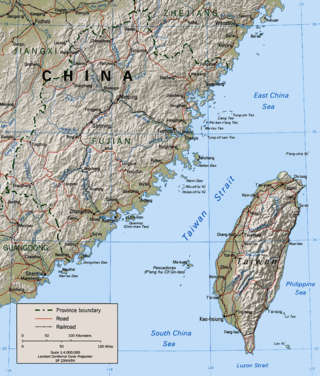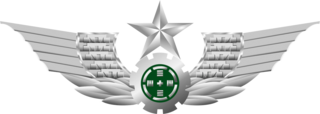
The Republic of China Armed Forces are the armed forces of the Republic of China (ROC) that once ruled Mainland China and now currently restricted to its territorial jurisdictions of Taiwan, Penghu, Kinmen and Matsu Islands. They consist of the Army, Navy, Air Force and Military Police Force. The military is under the civilian control of the Ministry of National Defense, a cabinet-level agency overseen by the Legislative Yuan.

The National Day of the Republic of China, also referred to as Double Ten Day or Double Tenth Day, is a public holiday on 10 October, now held annually as national day in the Republic of China. It commemorates the start of the Wuchang Uprising on 10 October 1911 which ultimately led to the collapse of the imperial Qing dynasty, ending 2,133 years of imperial rule of China since the Qin dynasty and establishment of the Republic of China on 1 January 1912. The day was once held as public holiday in mainland China during the Mainland Period of the ROC before 1949. The subsequent People's Republic of China continues to observe the Anniversary of the Xinhai Revolution at the same date but not as a public holiday, which put more emphasis on its revolutionary characteristics as commemoration of a historical event rather than celebration to the founding of the Republic of China.

The Second Taiwan Strait Crisis, also called the 1958 Taiwan Strait Crisis, was a conflict between the People's Republic of China (PRC) and the Republic of China (ROC). In this conflict, the PRC shelled the islands of Kinmen (Quemoy) and the Matsu Islands along the east coast of mainland China in an attempt to take control of Taiwan from the Chinese Nationalist Party, also known as the Kuomintang (KMT), and to probe the extent of the United States' defense of Taiwan's territory. A naval battle also took place around Dongding Island when the ROC Navy repelled an attempted amphibious landing by the PRC Navy.

The Battle of Kuningtou or Battle of Guningtou (Chinese: 古寧頭之役; pinyin: Gǔníngtóu zhī yì; Wade–Giles: Ku3-ning2-t’ou2 chih1 i4), also known as the Battle of Kinmen (金門戰役; Jīnmén Zhànyì), was fought over Kinmen in the Taiwan Strait during the Chinese Civil War in 1949. The failure of the Communists to take the island left it in the hands of the Kuomintang (Nationalists) and crushed their chances of taking Taiwan to destroy the Nationalists completely in the war.

The People's Liberation Army Ground Force is the land-based service branch of the People's Liberation Army and the largest and oldest branch of the entire Chinese armed forces. The PLAGF can trace its lineage from 1927 as the Chinese Red Army; however, it was not officially established until 1948.

The Republic of China Navy is the maritime branch of the Republic of China Armed Forces (ROCAF).

The Republic of China Marine Corps is the amphibious arm of the Republic of China Navy (ROCN) responsible for amphibious warfare, counter-landing and reinforcement of the areas under the jurisdiction of the Republic of China (ROC), including the island of Taiwan, Kinmen, and the Matsu Islands, and defense of ROCN facilities, also functioning as a rapid reaction force and a strategic reserve capable of amphibious assaults.

The Republic of China Air Force is the military aviation branch of the Republic of China Armed Forces, based in Taiwan since 1949. The ROCAF was founded in 1920 by the Kuomintang. While its historical name is sometimes used especially in domestic circles, it is not used as often internationally due to the current ambiguous political status of Taiwan and to avoid confusion with the People's Liberation Army Air Force of the People's Republic of China (PRC).

The People's Liberation Army Navy Marine Corps (PLANMC), also known as the People's Liberation Army Marine Corps (PLAMC), is the marine force of the People's Liberation Army (PLA) and one of five major branches of the People's Liberation Army Navy (PLAN) responsible for amphibious warfare, expeditionary operations and rapid responses. It currently consists of seven 6,000-man combined armed brigades and four other supporting brigades including aviation, engineering & chemical defense, artillery and service-support brigades for a total of 40,000. It further includes a brigade-level special operations unit called "Jiaolong Commando Unit"

The Republic of China Military Police is a military police body under the Ministry of National Defense of Taiwan. Unlike military police in many other countries, the ROCMP is a separate branch of the ROC Armed Forces. ROCMP is responsible for protecting government leaders from assassination or capture, guarding Taiwan's strategic facilities, and counterintelligence against enemy infiltrators, spies, and saboteurs.

The brigade combat team (BCT) is the basic deployable unit of maneuver in the U.S. Army. A brigade combat team consists of one combat arms branch maneuver brigade, and its assigned support and fire units. A brigade is normally commanded by a colonel (O-6) although in some cases a brigadier general (O-7) may assume command. A brigade combat team contains combat support and combat service support units necessary to sustain its operations. BCTs contain organic artillery training and support, received from the parent division artillery (DIVARTY). There are three types of brigade combat teams: infantry, Stryker, and armored.
The Battle of Nanri Island was a conflict between the Republic of China Army (ROCA) and the People's Liberation Army (PLA), over Nanri Island in today's Nanri Town, Xiuyu District, Putian, Fujian, People's Republic of China off the coast of Mainland China. This conflict occurred from 11 October 1952, to 15 October 1952, and resulted in a ROCA victory with complete destruction of PLA forces. However ROCA later abandoned this island and retreated, with all its captured prizes and POWs, to Taiwan.
This article provides formation lists of the Polish People's Army order of battle at various points in history between 1943 and 1989.

The 132nd Armored Brigade "Ariete" is currently the only active armored brigade of the Italian Army. Its core units are tank and Bersaglieri regiments. The brigade's headquarters is in Pordenone, and most of its units are based in the North-East of Italy. The brigade's name comes from the battering ram. The brigade draws much of its historical traditions from the 132nd Armored Division "Ariete," which fought in the Western Desert Campaign of World War II. In 1948, the Ariete was reconstituted as a division and remained active until 1986. Today the brigade is part of the Division "Vittorio Veneto".

The Type 08 is a family of eight-wheeled amphibious, modular armored vehicle developed by Norinco for infantry fire support, battlefield logistics, and quick reaction operations. Developed in the early 2000s, the modern Chinese vehicle family were produced for more than 6000 hulls and widely deployed by the People's Liberation Army Ground Force and People's Liberation Army Marine Corps.

The Eastern Theater Command is one of the five theater commands of the People's Liberation Army (PLA), founded 1 February 2016. It replaced the Nanjing Military Region. The command is headquartered in Nanjing.

The CM-11 Brave Tiger is a main battle tank (MBT) that was developed by the American General Dynamics and the Republic of China Army Armored Vehicle Development Center. It was introduced to the public on 14 April 1990. The CM-11 is a hybrid M60 chassis fitted with the turret from the older M48 Patton and the fire control system of the M1 Abrams.

The People's Liberation Army Air Force Airborne Corps is an airborne corps under direct command of the People's Liberation Army Air Force (PLAAF). It was reorganized and renamed from the 15th Airborne Corps in May 2017 and now comprises six airborne brigades and a special operations brigade. The PLAAF Airborne Corps is China's primary strategic airborne unit and part of the newly formed rapid reaction units (RRUs) of the Chinese military which is primarily designated for airborne and special operation missions. Its role is similar to that of the U.S. Army's XVIII Airborne Corps, the British Army's Parachute Regiment and the Russian Airborne Forces.

The Kinmen Defense Command is one of the defense commands under the Army of the Republic of China. Army force in Kinmen County, with a total strength of about 3,000. The commander is a lieutenant general. He is responsible for combat command and military control in the Kinmen area during wartime. In its heyday, the total strength was about 100,000. The team's name was originally "Qingtian" Force", has been responsible for the first-line defense tasks in the free areas of the Republic of China since its establishment. In March 2006, in compliance with the National Defense Organization Law, it was renamed the Kinmen Defense Command. It was formerly known as the Army's Twelfth Corps.





![General Chung Shu-ming [zh], the incumbent commander of the ROC Army Lu Jun Er Ji Shang Jiang Zhong Shu Ming 2023.jpg](http://upload.wikimedia.org/wikipedia/commons/thumb/9/9e/%E9%99%B8%E8%BB%8D%E4%BA%8C%E7%B4%9A%E4%B8%8A%E5%B0%87%E9%8D%BE%E6%A8%B9%E6%98%8E2023.jpg/220px-%E9%99%B8%E8%BB%8D%E4%BA%8C%E7%B4%9A%E4%B8%8A%E5%B0%87%E9%8D%BE%E6%A8%B9%E6%98%8E2023.jpg)










































![03.30 [Tai Bei Shi 106Nian Quan Min Fang Wei Ji 2017Tai Bei Shi Jie Da Xue Yun Dong Hui Zai Hai Fang Jiu Ji Jin Hua Yan Xi ] ,Yan Lian Kong , Di Li Ti Gong Jian 33578031842 d989f4acd4 o.jpg](http://upload.wikimedia.org/wikipedia/commons/thumb/2/20/03.30_%E3%80%8C%E8%87%BA%E5%8C%97%E5%B8%82106%E5%B9%B4%E5%85%A8%E6%B0%91%E9%98%B2%E8%A1%9B%E6%9A%A82017%E8%87%BA%E5%8C%97%E4%B8%96%E7%95%8C%E5%A4%A7%E5%AD%B8%E9%81%8B%E5%8B%95%E6%9C%83%E7%81%BD%E5%AE%B3%E9%98%B2%E6%95%91%E5%8F%8A%E9%87%91%E8%8F%AF%E6%BC%94%E7%BF%92%E3%80%8D%EF%BC%8C%E6%BC%94%E7%B7%B4%E7%A9%BA%E3%80%81%E5%9C%B0%E7%AB%8B%E9%AB%94%E6%94%BB%E5%A0%85_33578031842_d989f4acd4_o.jpg/120px-03.30_%E3%80%8C%E8%87%BA%E5%8C%97%E5%B8%82106%E5%B9%B4%E5%85%A8%E6%B0%91%E9%98%B2%E8%A1%9B%E6%9A%A82017%E8%87%BA%E5%8C%97%E4%B8%96%E7%95%8C%E5%A4%A7%E5%AD%B8%E9%81%8B%E5%8B%95%E6%9C%83%E7%81%BD%E5%AE%B3%E9%98%B2%E6%95%91%E5%8F%8A%E9%87%91%E8%8F%AF%E6%BC%94%E7%BF%92%E3%80%8D%EF%BC%8C%E6%BC%94%E7%B7%B4%E7%A9%BA%E3%80%81%E5%9C%B0%E7%AB%8B%E9%AB%94%E6%94%BB%E5%A0%85_33578031842_d989f4acd4_o.jpg)
































